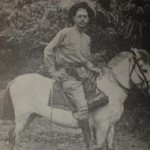 About the author: Telesforo Carrasco y Perez (1873 — September 22, 1916). Spanish gendarme, officer in the Philippine Army. Justice of the Peace in Nagcarlan.
About the author: Telesforo Carrasco y Perez (1873 — September 22, 1916). Spanish gendarme, officer in the Philippine Army. Justice of the Peace in Nagcarlan.
Telesforo was born in 1873 in Guadahortuna, Granada, in Southern Spain. He died in San Pablo, Laguna on September 22, 1916 at the age of 43. He had lived here in the Philippines some two dozen years, was married to a Batanguena from Tanauan, and had two children by her. Such in brief is the rather brief history of Telesforo Carrasco y Perez, the Andalusian who became a veteran of the Philippine Revolution.In his pictures, Telesforo Carrasco looks very Andaluz and romantic; raven-haired and dark-eyed, with a thin and straight nose, delicate lips, sleek face narrow with oval chin ajut. He was a person of refinement having been born to a wealthy family and brought up in the glamorous city of Cordoba but he preferred to loiter in the streets. To cut the story short, he ended up in the army, to be disciplined at a young age of 17. He later volunteered to serve in the Philippines where he arrived in September of 1892. He served with the army and the Guardia Civil. At the time of the Revolution, he was with the rural constabulary.When Spain lost the Philippines he surrendered to Pablo Tecson in Bulacan on June 1, 1899, eight years after he arrived in the Philippines. He waived repatriation to Spain and found himself serving in the ranks of the Philippine Army initially as an instructor then as a junior officer in Aguinaldo’s army in the war against the Americans. Eventually, among various assignments and missions, Telesforo became a part of Aguinaldo’s rear guard at Tirad Pass. There he witnessed the death of his commander, General Gregorio del Pilar, who was killed by an American sniper.As a testament to his valor, his family said that after his death a street in Binondo was named after him, but they are unsure if the street still bears his name today. Nick Joaquin says, “It may be that City Hall’s habit of changing Manila street names has made a victim of Calle Carrasco.”
A judicial/adminstrative summons published in the Gaceta de Madrid (Núm. 297, 24 Octubre 1903), describes the author:
REUS
D. José Coll Barea, segundo Teniente de Infantería con
destino en la Comisión liquidadora de Cuerpos disueltos de Filipinas, Juez instructor de la sumaria que se instruye contra el sargento Telesforo Carrasco Pérez.Por la presente cito, llamo y emplazo al referido sargento,
hijo de Joaquín y Olalla, de oficio del campo, de treinta años de edad, de estado soltero, su estatura un metro seiscientos milímetros, sus señas: el pelo castaño, cejas al pelo, ojos pardos, nariz regular, barba ninguna, boca regular, color trigueño, frente regular, aire marcial, producción buena; para que dentro del término de treinta días, á contar desde el en que se publique esta requisitoria, comparezca á este Juzgado, sito en Reus, ó ante la Autoridad del punto en que se halle; en la
inteligencia de que, de no hacerlo, será declarado en rebeldía.A la vez, encargo á las Autoridades civiles y militares dispongan su busca y captura, y caso de ser habido, lo pongan á mi disposición, coadyuvando así á la administración de justicia.
Y para su publicidad, insértese la presente en la G a c e t a
de M a d r i d .El segundo Teniente, Juez instructor, José Coll.
About the diary: A Spaniard in Aguinaldo’s army: The military journal of Telesforo Carrasco y Pérez, Solar Pub. Corp (1986) a translation by Nick Joaquin of Ligeros Apuntes de Mi Vida Militar.